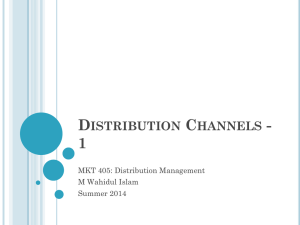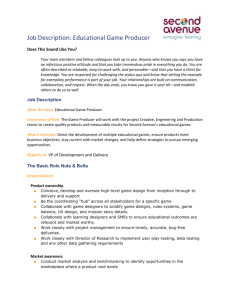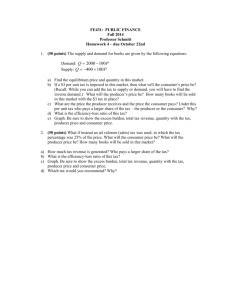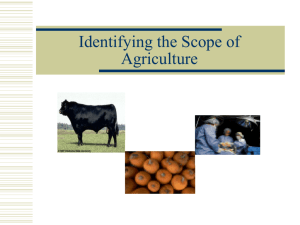.vV^^>ev li-e (Y)h' V
advertisement
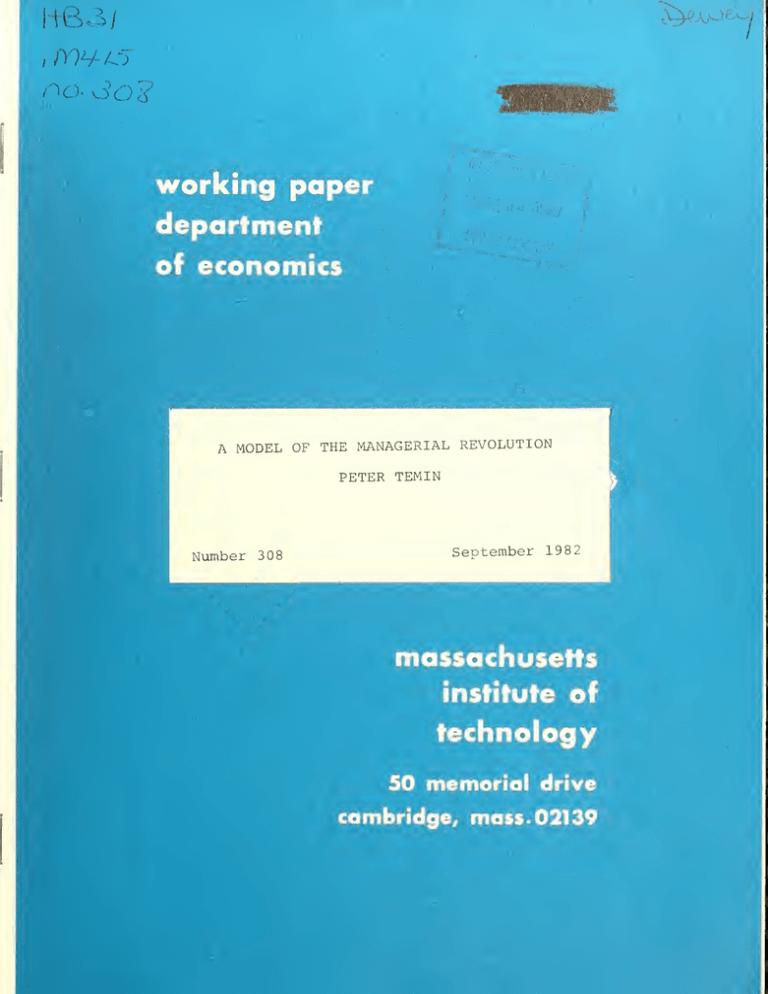
"' .vV^^>ev li-e , I ; (Y)h' / / "ic"!. .1'^ V ".' 1 A MODEL OF THE MANAGERIAL REVOLUTION PETER TEMIN Number 308 September 1982 * A MODEL OF THE MANAGERIAL REVOLUTION PETER TEMIN MIT ABSTRACT in The growth of large firms that integrated production and distribution recently by the late nineteenth-century U.S. has been chronicled often, most Alfred Chandler. The historical literature, with its emphasis on the formal integration of production and distribution, has not been amenable to economic analysis using the traditional tools of industrial organization.. This paper draws on the literature about prices vs. quantities and transaction costs to derive a simple model of firm integration under marketing. conditions of economies of scale in production and uncertainty in before World War The model then is used to analyze the managerial revolution One. * and Martin Helpful comments were received from Peter Diamond, Paul Joskow, Weitzman. All errors remain mine. Digitized by the Internet Archive in 2011 with funding from Boston Library Consortium Member Libraries http://www.archive.org/details/modelofmanageriaOOtemi - 1 . 1 - The Problem The transformation of American industry in the late nineteenth century- is typified by the career of Andrew Carnegie. By the end of the Civil War, Carnegie was a wealthy man with a variety of interrelated interests. He expressed these interests by owning major shares in a variety of different firms: blast furnaces, a rail mill, a fast-freight company, a locomotive works, a bridge-building firm, a sleeping-car company, and others. He consolidated all of his holdings into the Carnegie Steel Co. in the 1870s when he began to exploit the new Bessemer steelmaking technology. Thereafter he exercised his considerable entrepreneurial and managerial talents within a single organization. (Wall, As with Carnegie, 1970) so with Duke, Swift, and myriad other industrialists whose names live on today in the names of firms, philanthropic foundations, and educational institutions. While their predecessors had spread their talents over several organizations, the scale of some business firms had expanded enough by the late nineteenth century to engage their full attention. These firms produced, packaged, advertised and sold a product that often was new to the market. Francis Adams and Louis D. Contemporary observers like Charles Brandeis recorded their horror of these firms in tracts like Chapters of Eric and Other People's Money . The Muckrakers detailed the accusations against the new large firms and their leaders, the "robber barons." A revisionist literature has grown up in more recent years, as the generation that lived through the managerial revolution disappeared. Typified by Nevins' magisterial biographies, this literature portrayed the "robber barons" as progressive industrialists interested only in efficiency - 2 - and progress. This line of research has been summarized and synthesized by Alfred Chandler in his The Visible Hand (1977). Chandler sees the growth of large integrated firms as the response to profit opportunities opened up by new technologies. While there were many different innovations, Chandler sees most of them as parts of a unified change that drastically increased the volume of products produced and the ease with which they could be marketed to It was the combination of these two changes consumers. — that distribution — in led to the rise of the large, vertically production and in integrated industrial firm. Chandler presented his views in a narrative format. In keeping with the literature on which he drew, he constructed his intellectual edifice by piling one anecdotal brick on another. This process resulted in a classic and convincing story, but it did not render the underlying argument amenable to formal analysis. The narrative, in fact, tends to discuss the actual historical events with a kind of inevitability. There obviously were choices to be made, but the alternatives were not spelled out and evaluated. Instead, the choice actually made was assumed to be the proper one and described in detail. The growth and longevity of large firms suggests that many managerial choices were in fact made reasonably, but they do not give insight into the nature of the choice itself. successful; The question is not whether Andrew Carnegie was the question is why. ¥e need a model of the choice faced by late nineteenth-century industrialists to answer this question. The model should rank the alternatives under different initial conditions and provide a way to explain the extent of vertical integration we observe. The model to be presented here is firmly in the efficiency tradition and takes little notice of horizontal integration for the purpose of increasing market power. This is not to suggest that such activities were absent, only that they are not the focus of the present inquiry. This model applies to industries where "vertical integration and oligopoly preceded horizontal combination and monopoly." (Yeager, 1981, p. 242) Section II describes the events to be explained in more detail. The model is derived in Section III and used to illuminate the managerial revolution in Section IV. Section V draws some implications and conclusions from the preceding discussion. II. The Events to be Explained Alfred Chandler chronicles what he calls the managerial revolution in American business in The Visible Hand . The relevant part of his story for this discussion is his Part IV, entitled, "The Integration of Mass Production with Mass Distribution." This, briefly, is the event to be explained. Chandler distinguishes three types of industries that participated in this revolution. The first type included industries with new continuous- process manufacturing methods. Economies of scale in production in these industries led to a vast increase in the quantity of the product produced with an attendant fall in the price. In order to effect this dramatic move down demand curve for their products, producers had to integrate distribution with production. The second type of industry produced a perishable product. These firms needed to integrate distribution with production to ensure that - 4 - the product did not spoil before it reached the consumer. The third type of industry produced a product needing service after it was sold. Producers needed to integrate production and distribution, according to Chandler, to keep their products operating and thereby to keep up the demand for new products . , The question is not whether the distributional functions described by Chandler needed to be done. them. It is perfectly clear that someone had to do The question is why producers thought that it was preferable to integrate distribution services with production rather than purchase them on the market, that is, rather than let independent firms distribute the products. This question can be made clearer by a brief examination of a few of Chandler's examples. Each example is typical of the industry type to which it belongs. The American Tobacco Company was formed in 1890 as the result of events set in motion by James B. Duke in 1884 when he installed two continous- production cigarette-making machines capable of "saturating" the then existing cigarette market. (ibid,, p. 291) "Output soared. Selling became the challenge." The question here is what the actual challenge was. Price reduction, which accompanied the expansion of output (partly due to a fall in the cigarette tax), must have increased the quantity demanded. Apparently the quantity demanded at the price at which Duke wanted to sell was still not enough to absorb his output, and he advertised to shift the demand curve outward. But getting consumers interested was only part of the challenge; Duke had also to get cigarettes to stores where the consumers could buy them. He did this by establishing "a network of sales offices" that coordinated local advertising and the scheduling of shipments to "jobbers and a few large - 5 - retailers." retailers; The sales offices did not actually act as wholesalers or they signed "marketing agreements with wholesalers and retailers." (ibid.) What were the sales offices doing? Chandler reports in a general discussion that "the wholesaler could not be relied upon to order and maintain inventory so that the customer could be always sure of obtaining the product." (Ibid., p. 290) The sales offices informed wholesalers of this need and, presumably, signed contracts with them obligating them to keep adequate inventories. The question is why a price signal would not have done as well. If we are to trust the judgment of earlier entrepreneurs, these sales offices were not needed before. ¥hat had changed? they would lose sales. If wholesalers or retailers ran short, It was in their interest to be well-stocked. Yet the implication of Chandler's narrative is that a price signal was not as effective as a quantity signal from a local sales office. A further implication of Chandler's description is that full integration was not used by the new continuous-process manufacturers; they needed to do more than simply announce the availability of their product at a market price, but less than integrate forward into wholesaling or retailing. They did, however, take over the function of advertising their product from the wholesalers or retailers. The growth of Swift & Co. provides an example of a firm making a perishable product. Swift "became the first modern meat packer because he was the first to appreciate the need for a distribution network to store meat and deliver it to the retailers." (ibid., pp. 299-300) The introduction of the refrigerated railroad car enabled meat to be slaughtered at a central - 6 - location and shipped as dressed meat to the point of retail sale. The conditions under which the meat was stored and transported clearly had to he controlled carefully to avoid spoilage. But railroads refused to handle refrigerated cars in an attempt to retain their existing traffic in live animals. And the wholesalers, who also handled live meat before the introduction of refrigerated cars, boycotted the new refrigerated dressed meat. Swift consequently had to do his own distribution and wholesaling. Swift integrated forward further than Duke. Other firms producing perishable products, such as brewers, did likewise, even without the opposition from existing conveyers and wholesalers that faced Swift. ¥hile continuous-process manufacturers took over advertising and the coordination of wholesaling, the producers of perishable products also brought the wholesaling function into the producing firm. As with continuous-process manufacturing, the question is why independent firms could not have provided the services taken over by Swift and others. The producers could have introduced a differential pricing scheme, giving discounts to wholesalers who kept the meat well. Publicizing the discount and having one or two people per city to check on meat delivered to retail butchers presumably would have created market incentives for wholesalers to preserve the freshness of dressed meat. A final example, from an industry selling a product requiring ser^/ice after purchase, is furnished by the Singer Sewing Machine Company. As far back as 1859, Singer had retail stores with female demonstrators, (male) mechanics, and a manager who arranged credit purchases. These stores coexisted with other forms of distribution until the 1870's when Singer's successor as president of the firm decided to eliminate all other forms of - 7 - marketing. Independent agencies, according to Chandler, had trouble supplying marketing services, replenished inventories erratically, and did not pay their hills to Singer promptly. Instead of paying more to hire a better class of retailer, the Singer company decided to integrate forward to handle all its retail sales. Singer could have offered discounts to firms that supplied high-quality service, kept adequate inventories, and paid bills on time. The question is why integration was preferable so that the integrated firm achieved the success that it did. Why was it that direct control was more efficient than communication through the market? The story as told by Chandler has all the inevitability of good history. Yet it is the obligation of the economist to visualize alternatives. And it is embarrassingly easy to visualize market alternatives to the forward integration described by Chandler. ¥e need a model of distribution to show why one alternative was preferred to the other and to show why the makers of products requiring customer services integrated further than firms producing perishable products who in turn integrated further than continuous-process manufacturers. III. The Model Consider the problem facing the producer of a new product by a high- volume production method. The "new" product can be a genuinely new product (sewing machines, elevators), an adaptation of an existing product to a new market (roll photographic film for use by amateurs, ready-to-eat breakfast , - 8 - cereals), or a dramatic decline in costs that enables a previously existing product to marketed in a wholly new way (cigarettes, matches, soap). The important point is that the "new" product is being sold at an unfamiliar point on the demand curve, about which there is considerable uncertainty. Intrinsic novelty of the physical object is not relevant here. The problem faced by this producer is how to market his "new" product. In sharp contrast to the normal economic model, we assume that this problem is equal in importance to the problems in production. The producer has both to inform potential customers about the existance of his new product and to market the product to them. These two functions — advertising and diatribution--may be done together or separately, but they both must be done. The problem facing the producer is whether to do them himself, that is, within his own firm, or whether to work through other firms. If he chooses the latter course, he then has to choose whether to work through a quantity- based contracting arrangement or through a price-based market system. More formally, we can divide the producer's choices into four categories. (Williamson, 1981, pp. 1553-54) He can distribute his product by one of the following methods: a) independent wholesalers and retailers that purchase products from the producer on the open market and resell them, B) independent wholesalers and retailers that have a franchise or other contractual arrangement with the producing firm, C) branch offices of the producing firm for wholesaling and independent retailers D) branch offices of the producing firm for both wholesaling and retailing. t : - 9 - Assume that the producer has the simplest possible cost function. high-volume plant produces a fixed, large amount of the product, fixed cost, P. Marginal costs are zero up to Q, for a In the short run, the Q. producer cannot produce more than Q and does not wish to produce less. a price, p, His Given for his product, the producer's profits, B, are the following function of the quantity demanded, q B = (1 ) , P^d - ^ for - F for pQ q_j < Q q.^ > Q In this simple model, unsatisfied customers are assumed to wait patiently for new supplies, so there is no cost — to an excess demand. — other than forgone earnings Nevertheless, the producer will not want to forgo these earnings if he can avoid it. Since he is the sole producer of a "new" product, he faces a downward-sloping demand curve. marginal revenue is positive at Q, On the assumption that he will try to set p to make Q the quantity demanded. Setting the price in this context is far from trivial. By definition, the producer is dealing with an unfamiliar demand curve or an unfamiliar part of the demand curve. Neither he nor anyone else has experience with the demand for his "new" product, and his estimate of the demand curve must be conjectural. In addition, the demand curve may be a function of his actions in setting quality levels and advertising. The producer is working on a 33 of hypotheses that he may well not be able to communicate convincingly to others, either because they do not know the new product as intimately as he does or because they are more timorous in their approach to economic endeavors. And as noted, his projection of demand may be conditional on advertising and marketing activities that exist initially only in his mind. - 10 - ^1 B, C -F Figure 1 - 11 - Again, he may not be able to communicate his vision of the interaction of production and distribution to others. Nevertheless, the producer needs to consider the costs of advertising and marketing in figuring his profits. These costs need to be deducted from B to get the net profitability to the producer of making and selling his product. It is convenient to consider these expenses separately from the production costs here, so that B can be seen as the "benefit" from production and the costs of advertising and marketing as the "costs." The producer then seeks to maximize his net profit, or the difference between his "benefit" and his "costs." product. His problem is to induce distributors to handle Q units of his The question is whether communication by means of quantities or by means of prices is a better method of accomplishing this goal. Let advertising expenses be a fixed expense, A, independent of the quantity supplied. Distribution costs are assumed to be fixed per unit without any capacity constraint. That is, either the producer can hire an unlimited number of people at a constant wage to distribute his product or he can arrange for an unlimited number of independent firms to market his product at a given price. This wage or price may have to be quite high to induce people to handle a new product and to explore a new portion of the demand curve; it is a mistake to think of it as a simple competitive wage. There are also start-up costs for distribution, but they are assumed to be small relative to F. Since distributors handle different geographic areas, it is appropriate to think of several distributors for each producer for each producer and to include these start-up costs in the per-unit distribution cost. This distribution cost can be expressed as a markup, m, on each unit of - 12 the product. worthwhile. It must be less than the price to make marketing the product The producer's advertising and distribution costs therefore are: (2) C = A + mq, where m , < p. In fact, C must be less than B at Q for the product to be produced. The producer must be able to make positive net profits at his maximum output for him to even consider producing. (3) A+mQ < pQ-F A+F < (p-m)Q Using (I ) and (2): Total fixed costs must be less than average net revenue times maximum production. Like p, m is an unknown parameter at the outset. know with certainty how much marketing will cost. The producer cannot The cost will include payments needed to attract people into the distribution of this new and untried product as well as the direct costs of people's time. includes a risk premium in addition to a wage. That is, it The size of this risk premium is subject to uncertainty, although it presumably declines over time as the product becomes less "new." The B and C functions are shown in Figure between B and C is reached at the producer. Q. 1 . The maximum distance This is the position of maximum profit to The slope of B is not defined at Q, but the graph shows that B is "more curved" at Q than C. More precisely, a smooth approximation to B would show more curvature in a neighborhood of Q than would a similar approximation to C. As shown by ¥eitzman (1974), a quantity signal from producer to distributor would be preferred as a result. In fact, the advantage of a quantity signal over a price signal increases as the curvature - 15 of C decreases (given that B is the more curved of the two). This clearly makes sense. If a price signal were used to communicate with the distributors, the producer could easily find that a small variation in the signal could have a dramatic adverse effect on his profits. producer's price to distributors is (p-m). The If the producer sets (p-m) too high, that is, if he sets m too low, then distributors may refuse to handle his product, resulting in few or no sales. And if he sets (p-m) too low, then he has transferred profits to his distributors unnecessarily. Since the shape of his cost curve pushes the producer toward a fixed quantity of production, he does better to arrange for distribution of this quantity directly than to send out a price signal that will induce others to distribute just this amount. This reasoning does not fully characterize the situation in which there are many possible distributors. In that case, price signals have advantages that may offset the advantage of quantity arrangements deriving from the curvature of the cost and benefit curves. Using price signals, the producer can let the market winnow out the high-cost distributors in favor of their more efficient or better-placed competitors; among them himself. he does not have to choose The above reasoning therefore applies most where there are special requirements for efficient distribution that cannot be satisfied by random distributors. It might require special training (to be a repairman, for example) or special equipment (refrigerated cars) to do a good job distributing the new product. In either case, a distributor possessing the relevant human or physical capital would be a better distributor than one who did not. The producer therefore would not be willing to distribute through anyone who would pay (p-m) for his product; he would want to use only ) - u - those people he knew had and would use properly the necessary tools and . skills. Some of these needed skills may be quite general, even if not generally available in the late nineteenth century. It was assumed above that unsatisfied customers waited patiently for new supplies. But if the producer is launching a massive advertising campaign to convince potential consumers to try his new product, the success of this advertising may depend on the product being available at the same time. (Producers complained often about the problem of keeping their goods in stock at the wholesale or retail level.) If existing distributors lack the skills to keep their inventories replenished, the producer may want to deal only with those few who have these administrative skills or else — as will be discussed shortly — integrate forward to supply these skills himself. Since it matters under these circumstances who the distributor is, the producer will be interested in the distributor's identity as well as his willingness to pay (p-m) for the (undistributed) product. He will be willing to distribute only through a small n\imber of known organizations. In Williamson's (1979) terminology, the transaction between producer and distributor is idiosyncratic. (in Ben-Porath's (1980) terminology, it is an F-connection.) ¥e can conclude from this exercise that there are two circumstances in which producers will want to have quantity controls on distribution; 1 Where the product is so "new" that it is hard to know what the correct (p-m) would be to sell Q of the product at lowest cost. 2) Where distribution involves an idiosyncratic transaction, that is, where the requirements of distribution are such that there exists an entry 15 cost to efficient distribution of the product and the number of potential distributers is limited as a result. Given the choice of quantity controls, the producer still has to choose between a contractual arrangement and complete integration of production and distribution. (Flaherty, 1981) in this choice as well. Both of the factors just listed are important Newness promotes integration for several reasons. It may be hard to convince distributors to handle a new and untried product. The producer may understand that this product is desirable, plentiful and cheap, but he may find it hard to convince distributors that he can convince consumers that his product has these attributes. The distributor may not be willing or able to ensure that his inventories do not run out. It may be easier for the producer to take the risk of failure on himself, rather than to educate an independent distributor enough to get him to share it. He may find it easier to hire individuals, who are then liable only for the performance of their job, than to contract with firms, who have their organizations at risk as well. In addition, even if the producer can convince the distributors of the merits of his new product, they may want a high fee for sharing in the risk of failure of this new product. Having been let into the charmed circle of the well-informed, they may wish to be paid accordingly. Alternatively, they may simply be more risk-averse than the innovative producer. The producer then would find it more advantageous to hire, train and direct employees than to contract with another firm. By taking all the risk and by exploiting his information by himself, he need not share his profits with anyone else. Newness introduces a distributional element into the choice of business organization that is in addition to the efficiency considerations discussed - 16 - by Weitzman and Williamson. Finally, the very newness of the product means that its quality needs to be determined* Perishable products and products requiring repair or service clearly are subject to quality degradation. It is in the producer's interest to guarantee a high quality and dispell any uncertainty about it. For in the presence of uncertainty about the product's quality, the profit-maximizing quality and profits will be lower. (Shapiro, 1982) But the impact of high quality on the producer's profits would be an externality for independent distributors. Indeed there is a positive inducement for fraud if the consumer or retailer may purchase from someone else the next time around. (Darby and Kami, 1973) And misreprentation by distributors would lower the perceived quality of the product. The producer can guarantee quality, internalize the externality, and make all purchases repeated ones by integrating forward. Idiosyncracy similarly makes integration more attractive. Dedicated distributional resources —whether a single organization. The freedom to go elsewhere enjoyed by contracting human or physical — are best coordinated by parties (at the conclusion of a given contract) declines in importance as the transaction becomes more idiosyncratic and the relevant resources become more specialized. The cost of negotiating contracts with separate organizations rises as the requirements for efficient distribution become more complex and as the situation approaches bilateral monopoly. And if the possession of specialized talents or resources confers local monopoly power on a wholesaler or retailer, the producer may want to appropriate the resultant profits instead of allowing others to retain them. Very new products and products requiring idiosjrnc ratio distribution 17 networks will be distributed through branch offices (choice C or D, above). The producing firm will integrate into retailing as well as wholesaling if the need for specialized services or equipment extends into retail sales. Products that are less new or have less idiosyncratic distribution needs will be distributed through franchised firms or similar arrangements (Choice B) . And old products with non-idiosyncratic distribution requirements will be sold and resold on open markets (Choice A). Advertising could either be done by the producer or the distributor. If there was a one-to-one match of producers and distributors, it might not matter which one. But the present model assumes that there are more economies of scale in production than in distribution. Economies of scale in distribution derive from the idiosyncratic nature of one or more of the distributional transactions. While important to the analysis, these fixed costs come in far smaller units than the fixed costs of the continuous- process manufacturing plant. A typical equilibrium therefore has each producer distributing through several wholesalers or retailers when using separate firms. Advertising by any of these firms would generate considerable externalities, as the advertising increased the overall demand for the "new" product. Consequently, the producing firm advertises a "new" product, whether or not it integrates distribution into the producing firm. IV. Application of the Model The task now is to show how the model of Section III helps to explain the events described in Section II. This task will be accomplished in three - 18 - steps. First, we will use the model to show why the various types of industries described by Chandler adopted different integration strategies. Second, we will explain the strategies of some industries transformed after the revolution chronicled by Chandler. And third, we will look for an explicit test of the model, an exception that proves the rule. Chandler classified the industries undergoing transformations in the late nineteenth century into three categories: continuous processes, perishables, and products requiring customer service. These three classes can be arrayed along the continuum of newness and idiosyncracy in distribution. All three classes of firms produced "new" products, that is, they all either repackaged or drastically reduced the price of existing products if they did not actually supply a previously unavailable product. It is hard to rank these products by newness and, fortunately, not necessary. All of them had enough newness to make handling them uncertain and therefore to reduce the number of potential wholesale and retail outlets. Continuous-production firms had the least idosyncratic transactions in distribution. Ready-made cigarettes, cheap matches, and ready-to-eat breakfast cereals were new to the market, but they did not require any special handling in distribution or special instructions in use. Ordinary wholesalers and retailers therefore could handle their distribution and sale. Perishable products involved an idiosyncratic transaction at the wholesale level. Refrigerated meat and beer had to be kept under refrigeration and moved expeditiously to the market in order not to spoil. Specialized equipment (refrigerated railroad cars) and a dedication to a rapid turnover of inventories were needed for successful distribution, that is, to get the - 19 products to the market in a fresh enough condition to attract and hold consumers' interest. Existing wholesalers had neither the equipment nor the training needed to handle perishable products. The producers consequently- had to either supply them or find wholesalers who would supply them. In either case, the wholesalers handling these perishable products were not interchangeable with other wholesalers; the transaction between the producer and wholesaler was idiosyncratic. The makers of products requiring customer service faced an idosyncratic transaction at the retail level. Sewing machines, mechanical reapers, office equipment and elevators all required service while in use and some required training to use in addition. Since there were no existing repair facilities for these new products, the retailer had to supply them himself to convince customers to buy the product — since people would not buy without the assurance that repair and training facilities were available. Producers consequently had to either organize these facilities themselves or find retailers who would. In either case, the retailers of these complex products were not interchangeable with general-purpose merchants; the transaction between the wholesaler and retailer was idiosyncratic. It follows from these observations that all three types of firms should have used quantity signals in their distribution, but that they should have differed in their degree of forward integration. manufacturers should have integrated the least, Continuous-process using contractual arrangements with independent firms to distribute their products (option B, above). Producers of perishable products should have integrated into wholesaling (option C), and producers of products requiring customer service should have integrated forward into retailing as well (option D). As noted - 20 in Section II, this is what we obsej?ve. Since the model was constructed to explain the events in Section II, it is not surprising that it does. In order to decide whether this explanation is better than some other, we need to subject it to more stringent tests. The first additional test is to see how it describes industries undergoing technological transformation more recently. The computer and the pharmaceutical industries were both transformed after World War II. As a result of new technologies, they produced new products which had to be sold. Can this model explain how distribution was organized in these two industries? Computers, particularly when they were new, required extensive customer service. needed software. They needed repair, and they The customers, business firms, in this case, were in no position to buy computers without accompanying services. As described above with older forms of office equipment, IBM integrated forward into retailing, providing all the services that the companies needed. Pharmaceutical companies began to produce a new generation of antibiotic and other drugs in the years after World War II. While their manufacturing costs probably did not have the economies of scale of continuous-process manufacturers, the importance of the research and development needed to introduce new drugs allows us to use the asssumptions about cost made in Section III to approximate costs in the drug industry. The drugs themselves, while. new, did not have problems of storage or of service. Instructions were needed for their use, but physicians stood ready to provide them. actually required the physicians' The law intermediation in the use of the new drugs, but the doctors did not participate on the actual distribution of them. Direct dispensing by physicians had virtually disappeared in favor of sale by - 21 pharmacy. Drug companies consequently were in a position similar to that of the continuous-process manufacturers before World War I. They packaged their — particularly product and vastly expanded their advertising to doctors. But they continued to use wholesale and retail druggists to actually distribute their products. As the model indicates, their integration forward was important for their success, but limited in its scope. (Temin, 1980) But again, this is not a hard test. More industries could be found and described according to this model, fitting them with more or less difficulty into its framework = It would be nice to have an exception to the rule, a forward integration when conditions did not warrant it. The model predicts that such a forward integration would not succeed, that is, it would not offer advantages over disintegrated distribution and would not therefore caputure a large market. American Tobacco tried to build on its success with cigarettes and expand into cigars. Duke integrated wholesaling and retailing of cigars into his organization, even though he had not done so with cigarettes. Cigar Store chain of stores was the result. The United But cigars did not share the characteristics of cigarettes, much less of sewing machines or typewriters. Cigars were made by hand by skilled workmen; no continuous-process machine had been invented. And no new instructions or facilities were needed to sell or consume cigars. There was, in short, no reason to think that forward integration offered advantages over a disintegrated market oriented approach. And apparently, it did not; American Tobacco's share of the cigar market never exceeded 15 per cent. This is the exception that proves the rule. (Chandler, 1977, p. 589; Tennant, 1950, pp. 32-33) - 22 - V. Implications The model of Section III applies most strongly to "new" products, for the reasons outlined there. It therefore suggests that the value of forward integration should decline over time as new products become old products and as the information needed to distribute or service them becomes widespread. And we do observe some disintegration over time. Independent wholesalers and retailers emerge where branch offices and franchised dealers were before. Sewing machines, typewriters, and lately even computers, can be bought in New firms entered the meat-packing business, and the general- purpose stores. "Big Four" meat packers' share of commercial cattle slaughter declined from 50 percent in 1920 to 20 percent in 1956. (Yeager, 1981, p. 239) Nevertheless, many of the large, integrated firms, organized at the end of the nineteenth century remain dominant in their industries today. rate The of turnover in the top 100 firms was less than one-third as large after ¥orld War One as in the two decades before. And if firms in the top 100 are assumed to "survive" if they at least maintain the constant-dollar rate of growth of assets of the 100th largest firm, the contrast is even stronger. Only slightly more than one firm a year dropped from the list of the top 100 after the First World War, and less than one a year failed to "survive" under the looser definition. (Edwards, 1975) Chandler reports that the industrial location of large firms did not change between 1929 and I960. (Chandler, 1977, p. 370) Chandler suggests that the integrated organization itself created a barrier to entry. Manufacturing knowledge was not a barrier, nor were branding or advertising. "The most imposing barrier to entry in these ' - 23 - industries was the organization the pioneers had built to market and distribute their newly mass-produced products." (Chandler, 1977, p. 299) But if manufacturing expertise was not scarce, distributional skill probably wa3 not either. People could be found to handle products competing with the products of the existing firms. therefore. The organization could be duplicated, Why then did it pose a barrier to entry? The most probable explanation involves capital costs. The pioneer firm had few competitors, possibly none, while building up its distribution network. It therefore could sell its products at a profit or close to it while undergoing the initial expansion. Later firms, by contrast, had to compete against the already existing distributional network. They would operate at a loss until their networks were fully established. This argument is not completely convincing. development involved great uncertainty. The initial product Pioneering firms often had losses as they experimented with prices and selling techniques. And entrants should have been able to borrow if the only barrier was the need to copy an existing, easily described organization. More work needs to be done to provide an explanation for the continued dominance of the pioneering firms. In particular, quickly. the advantage of being first should not be dismissed so Two advantages come to mind. First, a firm that establishes a reputation for high quality enjoys market power as a result. Studies of the consumer response to brands suggests that this advantage is strong and lasting. (Bond and Lean, 1977; Schmalensee, 1979) ' If these findings are general, the potential entrant needs to overcome this loyalty advantage in order to compete successfully with the existing firm. Second, even if capital markets are functioning well, in the sense that anyone can borrow at - 24 - a price determined by the riskiness of the proposed use, it may be hard to borrow externally to finance the creation of a large production and distribution organization. The initial firm, by virtue of its existing position, may be able to draw on retained earnings to finance expansions, while the potential entrant has to borrow externally. The existing firm therefore is not forced to pay a risk premium to a lender outside the industry who has inadequate knowledge of the profit opportunities. And if lenders as well as customers are responsive to proven track records, the two advantages may interact; existing firms may find it easier to borrow as well as easier to sell their product. And anticompetitive activity should not be forgotten. Both the American Tobacco Company and the American Sugar Refining Company required their distributors to deal exclusively with them. Eichner, 1969, pp. 191-95) (Tennant, 1950, pp. 304-06; Marvel (1982) argues for an efficiency rationale for exclusive dealing, but his argument does not apply to either of these cases which involve homogeneous products and administered prices. Entry limitation was the motivation and the effect. The model presented here is a first attempt to formalize the argument implicit in Chandler's narrative of the managerial revolution of the late nineteenth century. It provides a basis both to understand the events he describes and for future research that will illuminate other episodes in our industrial history. - 25 - References Ben-Porath, Yoram. "Reflections on the F-Connection," Population and Development Review 6:1-30 (March, 1980). Bond, Ronald S. and David F. Lean. Sales, Promotion and Product Differentiation in Two Prescription Drug Markets Washington, DC: Federal Trade Commission, 1977. , . Chandler, Alfred D., Jr. The Visible Hand: The Managerial Revolution in American Business Cambridge: Harvard University Press, 1977. . Darby, Michael R., and Edi Kami. "Free competition and the Optimal of Fraud," Journal of Law and Economics 16:67-89 (April, 1973). Araoijxit Edwards, Richard C. "Stages in Corporate Stability and the Risks of Corporate Failure," Journal of Economic History 35:428-57 (June, 1975). Eichner, Alfred S. The Emergence of Oligopoly: Sugar Refining as a Case Study Baltimore: Johns Hopkins Press, 1969. Flaherty, M. Therese. "Prices versus Quantities and Vertical Financial Integration," Bell Journal of Economics 12:507-25 (Autumn, 1981). Marvel, Howard P. "Exclusive Dealing," Journal of Law and Economics 25:1-25 (April, 1982). Schmalensee, Richard. "On the Use of Economic Models in Antitrust: The ReaLemon Case," University of Pennsylvania Law Review 127:994-1050 (April, 1979). Shapiro, Carl. "Consumer Information, Product Quality, and Seller Reputation," Bell Journal of Economics 13:20-35 (Spring, 1982). Peter. Taking Your Medicine: Drug Regulation in the United States Cambridge: Harvard University Press, 1980. Terain, Tennant, Richard. B. The American Cigarette Industry University Press, 1950. Joseph F. Andrew Carnegie Wall, . New York: . New Haven: . Yale Oxford University Press, 1970. Weitzman, Martin L. "Prices vs. Quantities," Review of Economic Studies 41:477-91 (1974). Williamson, Oliver E. "Transaction-Cost Economics: The Governance of Contractual Relations," Journal of Law and Economics 22:233-61 (October, 1979). "The Modern Corporation: Origins, Evolution, Attributes,: Journal of Economic Literature 19:1537-68 (December, 1981). -. - 26 - Yeager, Mary. Competition and Regulation: The Development of Oligopoly in Greenwich, CN: JAI Press, 1981. the Meat Packing Industry. MIT LIBRARIES 3 9080 02164 1276
